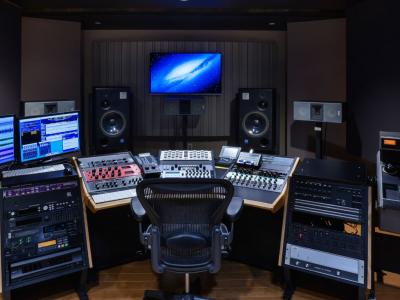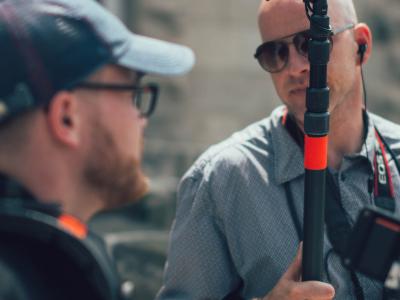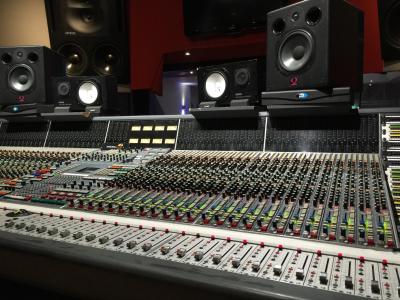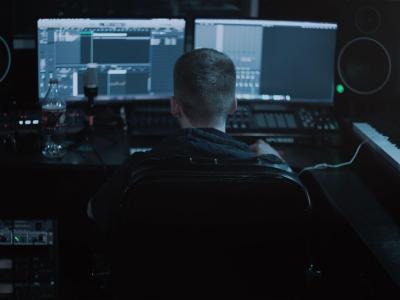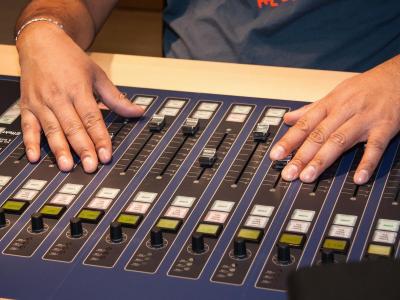12 Weeks
Level 3
3-Credit Tuition
$1,245Non-Credit Tuition
$1,090When you learn how to mix music that is pleasing to listeners, it is a true art form. The manipulation of the source signals’ level, dynamics, and panoramic position, and the addition of effects such as reverb and delay, can have a huge impact on the overall feel of a song. The Art of Mixing course explores the many creative and technical considerations necessary to mix in today’s music production environment, regardless of platform or format.
This course teaches the different steps of the mixing process. You’ll learn how to mix music using techniques, including equalization, panning, dynamic processing (compressors, gates, expanders, and limiters), reverb and delays, as well as automation techniques and practical examples. The methods presented apply to any Digital Audio Workstation (DAW), or digital or analog console.
The course analyzes some of the most famous and revered brands and models of mixing gear, including comparisons between analog and digital outboard gear versus plug-in emulations and plug-in unique processors. It features video, sound, and visual examples based on common platforms such as Pro Tools, Logic, and Digital Performer, as well as a hybrid mix performed in an SSL 4000 G console, combined with Pro Tools and a huge variety of outboard gear.
Students will learn how to mix music by delivering a new piece every week for critique by the instructor. For each mix assignment, students will use professional recordings specially made for the course, in a variety of styles. The goal of the course is to impart both a technical and artistic approach to mixing and for students to acquire the core skill set needed to mix multi-track master recordings to a stereo final mix-down suitable for release.
By the end of this course, you will be able to:
- Understand the technical requirements needed to prepare recording tracks for mixing
- Implement professional music standards for organizing your mix session and delivering the final mix
- Apply editing tools needed to improve musical performance, such as vocal tuning, vocal comping, and tempo editing
- Understand and use different types of equalizers, compressors, gates, reverbs, delays, chorus, flangers, and many other processors necessary to mix effectively
- Employ automation techniques, from basic to using all kinds of parameters
- Apply mixing techniques specific to drums and vocals
- Thoroughly analyze and evaluate your own mix and others
- Identify the main mixing trends per genre of contemporary music
Syllabus
Lesson 1: Overview of Mixing Music
- Overview and History of Mixing
- Mixing is Balance
- Level and Loudness
- Level Adjustment
- Panning
- Panning Strategies
- Practice Exercise: Build Your Reference Library
- Muting Techniques
- Building a Mix
- Dynamic Mix
- Assignment 1: Mix 'Ghosts' by Amy Rivera
Lesson 2: Mix Setup: Organization, Ergonomics, and Phase Relationships
- Recommendations from the Music Industry
- Create One Master Project/Session
- Label Audio Tracks and Use Comments
- Label Appropriately and Set the Date and Time
- File Format, Sample Rate, and Bit Depth
- Use Tempo Map and Timeline Markers
- The Clean-Up Process
- Keep Tracks Organized
- Essential Plug-Ins
- Automation
- Data Management, Storage, and Transfer
- Compatibility Between DAWs
- The Importance of Metering
- The Importance of Gain Staging
- Simple Mix
- Mixing Levels and Delivery Standards
- Dynamic Range
- Standard Operating Level (SOL)
- TV and Instrumental Mix
- Phase Relationships Between Tracks
- Exporting the Mix
- Assignment 2: Mix Revision for 'Ghosts' by Amy Rivera
Lesson 3: Equalization Techniques
- Equalizers: Theory
- Equalizers: History and Application
- EQ Parameters
- Q Factor
- Slope
- EQ Types: Graphic Equalizers
- EQ Types: Shelving Equalizers
- EQ Types: Parametric Equalizers
- Filters
- Plug-ins vs. Analog Hardware EQ
- What Are Those Advantages?
- Why Do We Still Use Analog EQ?
- Creative Equalization Techniques
- Subharmonic Enhancers & Aural Exciters
- Classic Analog EQ: SSL
- Neve 084
- Neve 073
- API 550
- API 560
- Pultec
- GML
- Manley
- EQ with Plugins
- Assignment 3: Mix 'Gone' by Ella Atkinson
Lesson 4: Reverb and Delays
- Reverb as an Acoustical Phenomenon
- Delay as an Acoustical Phenomenon
- Reverb and Delay: History and Application
- Reverb Parameters
- Chamber Reverb
- Spring Reverb
- Plate Reverb
- Halls and Room Reverb
- Delay Parameters
- Tape Delay
- Ping Pong Delay
- ADT Delays
- Setting Up a Short Delay in a Mix
- Analog vs. Digital, Plug-in vs. Hardware
- Plug-ins
- Assignment 4: Mix Revision for 'Gone' by Ella Atkinson
Lesson 5: Automation Techniques
- Automated Mixing Overview and Historical Perspective
- Winds of Change in the '70s
- Full Automation and Digital Consoles in '80 - '90
- Predicting the Future?
- Main Physical Automation Systems
- VCA (Voltage-Controlled Amplifier)
- Flying or Moving Faders
- Total Recall
- Automation in Analog Consoles
- Automation in Digital Consoles and DAWs
- Digital Consoles vs. DAWs
- Modes of Operation for Automated Mixes
- Write
- Read
- Update
- Setting for Automation Systems
- Hands-on Options: Real Time, Off-Line or Snapshot Automation
- Real Time Automation Techniques
- Off-Line or Playlist Automation
- Snapshot Automation
- Assignment 5: Mix ‘I Haven't Seen an Angel Tonight' by Rêverie
Lesson 6: Dynamics Processing Part
- What is the Purpose of Compression?
- Compression Controls and Functionality: Threshold
- Compression Controls and Functionality: Ratio
- Compression Controls and Functionality: Attack
- Compression Controls and Functionality: Release Time
- Output or Make-Up
- Practical Applications for Compression in Mixing
- A Step-by-Step Approach
- The Difference Between Compression and Limiting
- Ratio-Based Definition of Limiting
- Brickwall-Based Definition of Limiting
- The Anatomy of a Mix
- Assignment 6: Mix Revision for ‘I Haven't Seen an Angel Tonight' by Rêverie
Lesson 7: Dynamics Processing Part
- Bus Compression
- Drum Bus Compression
- Multiple Bus Compression
- Stereo Bus Compression
- Side-Chain Triggered Compression Effects
- Side-Chain Triggered Drum Bus Compression
- Side-Chain Triggered Stereo Bus Compression
- Pumped Compression of the Bass Triggered by the Kick
- Miscellaneous Compression FX
- Multi-Band Compression
- Hardware Compressor Demonstration
- Plugin Compressor Demonstration
- Noise Gates/Expanders
- Noise Gate Controls and Functionality
- Noise gating: a Step-by-Step Approach
- Keyed Noise Gating
- Assignment 7: Mix 'Feel Bad' by Doll
Lesson 8: Miscellaneous Unusual FX and Secret Techniques
- Time-Based Special Effects: Chorusing, Flanging, and Phasing
- Effects Processors Parameters
- Chorusing
- Flanging
- Phasing
- Amplitude-Based Effects: Tremolo, Wah, Leslie Cabinet
- Tremolo
- Wah
- Leslie Cabinet
- Image Widening or Stereo Enhancing
- Distortion
- Reamping and Amp Simulation
- Exciters and Sub-Harmonic Enhancers
- Reverse Processing
- Tape Emulation
- Vocoder and Talk-Box
- Noise Reduction
- Assignment 8: Mix Revision for 'Feel Bad' by Doll
Lesson 9: Vocal Mixing Techniques
- Preparing Vocals for the Mix: Vocal Editing, Tuning, and Time Correcting
- Vocal Comping
- Timing Editing
- Pitch Correction
- Additional Vocal Editing
- Vocal EQ, Dynamic, Gain Setting, Leveling
- Vocal EQ
- Dynamic Control and Leveling of the Vocal Tracks
- Vocal De-essing
- Gain Setting
- FX Processing
- Assignment 9: Mix 'Therapy' by Andie Mechanic
Lesson 10: Drum Mixing Techniques
- Preparing Drums for the Mix
- Phase Relationship between Drum Tracks
- Drums Editing: Time Corrections
- Grouping Drum Tracks
- Stereo Processing
- Parallel Processing
- Drum Sound Replacement
- Mixing MIDI Sequenced Drums and/or Loops vs. Acoustic Drums
- Mixing Acoustic Drums
- Mixing Sequenced Drums and Loops
- Assignment 10: Mix Revision for 'Therapy' by Andie Mechanic
Lesson 11: Instrumental Mixing Techniques
- Mixing Bass: Acoustic, Electric, and/or Synthesized
- Electric Bass
- Acoustic Bass
- Synthesized Bass
- Mixing Electric and Acoustic Guitars
- Mixing Electric Guitars
- Mixing Acoustic Guitars
- Mixing Horns and Strings, Both Real and Synthesized
- Strings
- Horns
- Mixing Less Common Instruments
- Deconstructing a Mix In-a-Box
- Assignment 11: Mix 'My Way' by Kylie
Lesson 12: Specialized Mix Directions and Techniques
- An Overview to Mixing Pop
- Common Pop Trends
- Mix Analysis of Pop
- An Overview to Mixing Rock
- Common Rock Trends
- Mix Analysis of Rock
- An Overview to Mixing Hip-Hop and R&B
- Mix Analysis of Hip-Hop and R&B
- An Overview to Mixing Jazz
- Mix Analysis of Jazz
- Assignment 12: Mix Revision for 'My Way' by Kylie
Requirements
Prerequisites and Course-Specific Requirements
Prerequisite Courses, Knowledge, and/or Skills
Completion of Critical Listening 1 or equivalent knowledge and experience is required. Students should understand the basic techniques involved in recording, editing, and mixing supported by their Digital Audio Workstation (DAW) of choice.
Textbook(s)
- No textbooks required
Software
- Full-featured Digital Audio Workstation (DAW), such as Pro Tools (Studio or Ultimate), Logic Pro, Cubase Pro, Ableton Live (Suite or Standard), Reaper, Reason, or FL Studio (Producer or Signature). Note that GarageBand is not acceptable.
Hardware
- Audio interface
- Studio monitors (pair), such as JBL 305Ps or better, as well as necessary cables
- Professional over-ear studio headphones, such as Sennheiser HD 600, beyerdynamic DT 770 PRO, etc.
Student Deals
After enrolling, be sure to check out our Student Deals page for various offers on software, hardware, and more. Please contact support@online.berklee.edu with any questions.
General Course Requirements
Below are the minimum requirements to access the course environment and participate in Live Chats. Please make sure to also check the Prerequisites and Course-Specific Requirements section above, and ensure your computer meets or exceeds the minimum system requirements for all software needed for your course.
Mac Users
PC Users
All Users
- Latest version of Google Chrome
- Zoom meeting software
- Webcam
- Speakers or headphones
- External or internal microphone
- Broadband Internet connection
Instructors
Author
Richard Mendelson is a senior faculty member in the Music Production and Engineering department at Berklee College of Music. A long-time educator, Mendelson specializes in mixing and recording. His former students include many Grammy-winning mixing and recording engineers.
Mendelson's work has been featured in recordings by artists such as Rihanna, Nicole Scherzinger, Fergie, and Garbage, and he is a first-call mix-down engineer in the Boston area. Mendelson is an expert in digital sampling and has created more than 10 international best- selling sample products for Big Fish Audio and East/West Communications. Read Less
Author & Instructor
Alejandro Rodriguez is an associate professor in the Music Production and Engineering department at Berklee College of Music, with more than 20 years of experience as a recording, editing, mixing, mastering, post-production, and live sound engineer and producer. He has worked with artists such as Mariah Carey, Compay Segundo, Eliades Ochoa and AfroCuban All Stars (from Buena Vista Social Club), Silvio Rodriguez, Pablo Milanes, J.M. Vitier, Grupo Niche, Armando Mnazanero, Ricardo Arjona, Pancho Cespedes, and Tania Libertad.
Prior to Berklee, Alejandro was an acoustics professor at the National School of Arts (ENA) and a professor of sound studies at Instituto Superior de Artes (ISA)—both in Havana, Cuba. He has also taught audio and recording techniques at the Instituto Tecnológico y de Estudios Superiores in Monterrey, México. Alejandro worked as a staff engineer for EGREM Studios in Havana, Cuba, and has since pursued a freelance career as an engineer and producer. He holds a bachelor's degree in music from ENA and a bachelor's degree in arts communication (specializing in sound for film, radio, and TV) from ISA. In addition, he studied telecommunication engineering at the Technical University in Havana and recording techniques at the Supraphon Recording Faclities in Prague, Czech Republic. Read Less
Instructor
Rachel Alina is a New York-based mixing engineer who has worked in every production situation imaginable, with artists ranging from Stephen Marley and Federico Aubele to Birdie Busch and P!nk. Her mixes utilize both vintage analog equipment and modern digital processing to give records the depth of both worlds. Rachel graduated from Berklee in 2003. She worked for Shelly Yakus, Greg Wells, and Henry Hirsch before becoming a freelance Mixing and Mastering Engineer.
Instructor
Producer John Escobar is also an engineer, multi-instrumentalist, and educator. Born to a Colombian father and a Mexican American mother, he grew up in a multicultural environment across multiple continents, spending his childhood in several countries in South America and his adolescent years in East Africa. Having the privilege of experiencing life from this angle, he gained a deep appreciation for the music and sounds of the world early on.
Escobar is well known for his versatility, which he attributes to his culturally diverse upbringing. His work has spanned many genres over the years, allowing him to work with such great artists as the multi-Grammy nominees Highly Suspect, the jazz guitar virtuoso Larry Coryell, Grammy-winning folk artist Sarah Jarosz, indie pop band Fences (featuring the Grammy-winning hip-hop duo Macklemore and Ryan Lewis), and classical violin virtuoso Joshua Bell, among many others. Over the last few years, he has had a chance to spend some time in academia, having taught at some of the most prestigious institutions in North America, such as Boston University, University of Southern California, Northeastern University, and Harvard University. He enjoys sharing his real-world knowledge with the up-and-coming talent in the music industry. Read Less
Instructor
Dan Pfeiffer is an assistant professor in the Music Production and Engineering (MP&E) department at Berklee. Since graduating from Berklee, he has been working full-time as a sound engineer with a specialization in immersive post-production and classical location recording. His Atmos work as engineer and assistant includes projects for UMG, Warner Music, Jacob Collier, and an album that won the first-ever "Spatial Audio" UK Gramophone award. Dan's recording work ranges from voiceover for Bethesda Games to orchestral and choral work.
Out of the studio, Dan has done audio-visual design and installation work for MIT as well as performance and broadcast facilities in New England. He is an active performer and conductor, and also serves as a board member for the fine arts non-profit Arts Empowering Life Foundation. Read Less
Instructor
David Lefkowitz has been teaching in higher education since 2000. He has taught courses such as physics, acoustics, electronics, sound design for visual media, music theory, audio technology, digital audio, advanced recording, and advanced mixing. David served as the assistant department chair for the Audio Production department at the New England Institute of Art. He also moderated/coordinated for the Boston area Pro Tools User Group (PTUG) and has presented at the Parson’s Expo and at other events. He is a Pro Tools certified expert instructor.
Under his independent business name, Lefko Productions, David worked on records with international and regional artists including Johnny A, Stuart Kimball, the Beloved Few, Entrain, Kol B’Seder, Dany Silva, Bana, and the Mendes Brothers. Bana and the Mendes Brothers were featured in the Putumayo World Disk Series. Dave was a principal business partner of Renaissance Recording Company, a commercial recording facility in Boston’s Back Bay where he worked as the chief recording engineer.
David's passions are composition and songwriting and he is currently producing his fifth full-length album. David is additionally skilled as a playwright, a show producer, a show director, and as a musical artist. Unyfi, David's audience-centered comical rock arts show featured his compositions. Unyfi performed at the Regent Theatre and at A.R.T. Oberon in 2015. Recently, David has been venturing into sound design and so far has worked on various films including Archie's Betty, Celling Your Soul, and Whaling City. David also produced and directed a film dedicated to the legendary Boston rock club "The Rat," featuring a variety of Boston rock artists including the Dropkick Murphys. He is a member of the Audio Engineering Society (AES) and Broadcast Music Inc. Read Less
What's Next?
When taken for credit, Art of Mixing can be applied towards the completion of these related programs:
Related Certificate Programs
Related Degree Majors
Questions?
Contact our Academic Advisors by phone at 1-866-BERKLEE (U.S.), 1-617-747-2146 (INT'L), or by email at advisors@online.berklee.edu.

